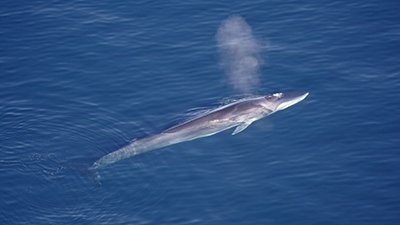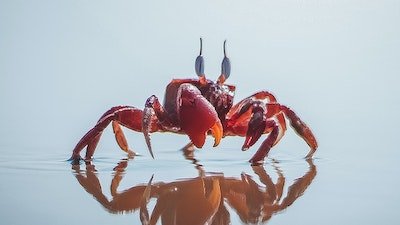Horseshoe Crabs—Divinely Designed Medical Marvel
There are very few animals with common names that are more misleading than the horseshoe crab. It is not horseshoe-shaped, but if one were pressed for an instantaneous answer, you might blurt out “frying pan” or “lollipop-shaped” if looking at the dorsal (top side). If you were looking at its underside and you are a fan of sci-fi horror movies, you would immediately think of the juvenile (face-sucker) form from the movie Alien. Neither is it a crab, but is classified as an arachnid, more like an underwater scorpion than anything else. In fact a fairly recent news release highlighted that horseshoe crabs may be closely related to the arachnid Order Ricinulei.1 While the biblical baraminological placement is not yet established, there are biblical kinds that go as high as the Order level, so this may be possible.
Like many other invertebrates the horseshoe crab has an exoskeleton made up of chitin. Its “shell,” or carapace, is composed of three sections: the cephalothorax (prosoma), the abdomen (opisthosoma), and the tail (telson). The telson of the horseshoe crab is almost as long as its body and is often mistakenly thought to be a stinger. It actually serves more as a rudder and occasionally as a “kickstand” to help it right itself if it gets turned upside-down in the water or on the beach. The abdomen contains many of the major muscles for the tail and the book gills. The book gills serve as both the membranes which absorb oxygen from the water and also as an undulating aid in swimming.2
Horseshoe Crab Eyes
One of the truly uniquely designed features on a horseshoe crab is its visual system. It has 10 eyes. The two largest are the dorsal-lateral eyes, which are compound eyes having about 1,000 photoreceptors each. In addition, the horseshoe crab has five additional eyes on the top side of its prosoma. Each of these eyes is specially designed to allow it to detect ultraviolet light. This allows the horseshoe crab to be able to see reflected moonlight in and on the surface of the water. Since their life cycle is dependent on spawning peaks during new and full moons, these five dorsal eyes are vital for their reproduction. There are also two eyes on the underside of the crab near its mouth, which help it keep its orientation while swimming. Finally, there is an eye (actually an interconnected series of photoreceptors) on the tail that serves as an aid in helping the animal keep its day and night cycles synchronized.3 For an alleged “primitive creature,” there seems to be an abundance of design features perfectly suited for the animal to survive and thrive.
The horseshoe crab, which has been around according to evolutionary timelines for supposedly 445 million years, surely has aged well (and even that putatively oldest fossil, Lunataspis aurora, looks remarkably similar to modern horseshoe crabs).4 It is often mentioned that Jurassic horseshoe crab fossils (usually of the extinct genus Mesolimulus) are living fossils, and not just by creationists.5 Even evolutionary displays at some zoos and museums have mentioned that the fossil versions look almost identical to living specimens.6
Types of Horseshoe Crabs & Medical Benefits
Horseshoe crabs are in the family Limulidae, with three living genera. There are four living species of horseshoe crab, three of which are found in the Pacific Ocean of Southeast and East Asia: Carcinoscorpius rotundicauda, the mangrove horseshoe crab; Tachypleus gigas, the Malaysian or coastal horseshoe crab; and Tachypleus tridentatus, the tri-spine horseshoe crab. Lastly, there is Limulus polyphemus, the Atlantic or American horseshoe crab, found along the American Atlantic coast and in the Gulf of Mexico.
For the past 40 years, humans and their pets have benefitted greatly from the horseshoe crab. Its blue blood (due to the high concentration of copper) has been at the center of an indispensable diagnostic test for endotoxin. Endotoxin is a component of the cell wall of Gram-negative bacteria, and its presence causes a severe immune response in humans and many animals. If it enters the bloodstream, it can cause fever, toxic shock, and even organ failure. Many vaccines, IVs, and implanted devices (like pacemakers, artificial knee joints, etc.) potentially can carry traces of endotoxins even after sterilization and therefore must be screened for its presence. That’s where horseshoe crab blood comes in. Their blood is highly sensitive to Gram-negative bacteria and endotoxin and actually gels in the presence of endotoxin.7
In the late 1960s, research was begun to see if the blood from Limulus polyphemus could detect the presence of endotoxin. Similar work was started a few years later with Tachypleus tridentatus. Both research programs were successful, and the LAL (Limulus amebocyte lysate) and TAL (Tachypleus tridentatus lysate) tests to detect endotoxin were developed in the 1970s, quickly becoming a standard procedure for medical labs and diagnostics. The procedure for each of the lysate tests uses horseshoe crab blood, which forms a gel clot in a test tube when endotoxin is present in the test sample. In addition to being diagnostic for endotoxin, horseshoe crab blood is able to detect beta-glucans, which may indicate fungal infections, within hours, whereas conventional diagnoses can take up to a week.8 Horseshoe crabs have definitely been a godsend medical miracle for mankind.
Threats to Horseshoe Crabs & Conservation
Such diagnostic tests require actual blood from horseshoe crabs. Therefore, they are a staple of the medical industry and are raised in aquacultures or caught commercially and then bled in laboratories. Horseshoe crabs can afford to “donate” up to a third of their blood at a time, but that much bloodletting is risky for the crab and some die. Since the 1980s, restrictions have been placed on harvesting horseshoe crabs for commercial or biomedical research, and state parks and national sanctuaries have been set aside to ensure that crab numbers did not decline. In 2001 the National University of Singapore synthesized the DNA for one of the blood-clotting factors of horseshoe crab blood factor C and was able to artificially produce recombinant factor C (rFC), which is able to detect endotoxin and does not require horseshoe crab blood. In 2012 the United States FDA ruled that the recombinant factor C (rFC) test was as efficient as the standard LAL tests, and could be used in its place. Consequently, American horseshoe crab numbers have responded positively in some regions, but Asian horseshoe crabs remain in decline from overfishing and overharvesting for their blood.9
Other conservation methods and harvesting methodologies are all being initiated in order to meet the increased demand for horseshoe crab blood, as well as to minimize the need for their blood by developing the use of alternative endotoxin tests.10 However, the organization that sets the standard for US has decided to stick with the tried-and-true blood for endotoxin screening for now; thus, current production of COVID vaccines are utilizing the horseshoe crab blood in the US.
Thankfully conditions have improved somewhat for crab blood harvesting over the years and more improvements are hopefully on the horizon. Compassionate animal care is a biblical principle of stewardship, especially for an animal that has been so beneficial to the health of mankind. We are reminded in Scripture that “A righteous man regards the life of his animal, But the tender mercies of the wicked are cruel” (Proverbs 12:10 NKJV). May we be counted as good and faithful stewards (1 Corinthians 4:2) of the resources God has given us to mitigate the disease and suffering we brought into his creation, as recorded in Genesis 3.
Footnotes
- Science Daily, “Horseshoe crabs are really relatives of spiders, scorpions,” March 8, 2019, https://www.sciencedaily.com/releases/2019/03/190308180302.htm.
- PBS.org Nature, “Crash: A Tale of Two Species: Horseshoe Crab Anatomy,” March 13, 2011, http://www.pbs.org/wnet/nature/crash-a-tale-of-two-species-horseshoe-crab-anatomy/593/.
- “Horseshoe Crab Anatomy,” Maryland Department of Natural Resources, accessed March 15, 2019, https://dnr.maryland.gov/ccs/Pages/horseshoecrab-anatomy.aspx.
- David M. Rudkin, Graham A. Young, and Godfrey S. Nowlan, “The Oldest Horseshoe Crab: A new xiphosurid from Late Ordovician Konservat-Lagerstatten deposits, Manitoba, Canada,” Palaeontology 51, no. 1 (2008):4–5, figures 2 and 3, https://onlinelibrary.wiley.com/doi/epdf/10.1111/j.1475-4983.2007.00746.x.
- “Solnhofen Mesolimulus Horseshoe Crab Fossil,” Virtual Fossil Museum, accessed March 15, 2019, http://www.fossilmuseum.net/Fossil_Sites/solnhofen/Mesolimulus-walchi/Mesolimulus.htm.
- “Horseshoe Crab facts,” Saint Louis Zoo, Accessed March 15, 2019, https://www.stlzoo.org/visit/thingstoseeanddo/stingraysatcaribbeancove/horseshoecrabfacts.
- “Biomedical Application of the Horseshoe Crab: The horseshoe crab and public health,” The Ecological Research & Development Group, accessed March 15, 2019, http://www.horseshoecrab.org/med/med.html.
- Ibid.
- “Achieving Sustainability,” The Ecological Research & Development Group, accessed March 15, 2019, http://www.horseshoecrab.org/med/trainwreck.html.
- Jordan Krisfalusi-Gannon, et. al., “The Role of Horseshoe Crabs in the Biomedical Industry and Recent Trends Impacting Species Sustainability,” Frontiers in Marine Science 5 (2018): 9–10, https://doi.org/10.3389/fmars.2018.00185.
Recommended Resources

Answers in Genesis is an apologetics ministry, dedicated to helping Christians defend their faith and proclaim the good news of Jesus Christ.
- Customer Service 800.778.3390
- © 2024 Answers in Genesis





